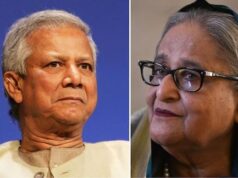Energy trade now slipping out of US control

On 14 Feb 1945, US President Franklin D Roosevelt met Saudi King Abdul Aziz Ibn Saud on the American cruiser USS Quincy. It wasthe beginning of one of the most important geopolitical alliances of the past 70 years, in which US security in the Middle East was bartered for oil-pegged in dollars.
But times change, and 2023 may be remembered as the year that this grand bargain began to shift, as a new world energy orders taking shape. India and China with their phenomenal rise in energy demand are re writing the rules, slowly but surely.
While China has for some time been buying increasing amounts of oil and natural gas from Iran, Venezuela, Russia, and parts of Africa in itsown currency, now India too has started on this route not only for oil but its entire bilateral trades.
A further impetus has been accorded to the process by Chinese President Xi Jinping’s meeting with Saudi and Gulf Co-operation Council (GCC) leaders in December.
So nowthe rules of the global energy are being rewritten with control being prised out of USA and European hands. Their sanctionsand price cap on Russian oil has backfired badly. Now the BRIC countries— Brazil, Russia, India and China, and many other parts of the worldhave started to de dollarize after the West carried out the weaponisation of dollar foreign exchange reserves following Russia’sinvasion of Ukraine.
What does that mean in practice? To begin with, a lot more oil trade will be done in renminbi and INR. Both Jaishankar and Xi have announced that, over the next three to five years, India and China would not only dramatically increase imports from GCC countries, but work towards importing oil from wherever it is cheapest and also work towards overall energy cooperation.
This could potentially involve joint exploration and production in places such as the Russian Far East, Sea off Southern coasts of China as well as investments in refineries, chemicals, and plastics. They will all be paid for in the local currencies of the parties involved.
That would mark a massive shift in the global energy trade. As Pozsar points out, Russia, Iran, and Venezuela account for 40% of OPEC+ proven oil reserves, and all of them are selling oil to India andChina at a steep discount while theGCC countries account for another 40% of proven reserves. The remaining 20% are in regions within the Russianorbit.
Those who doubt the rise of the INR and Yuan, and the diminution of the dollar-based financial system in general, often point out that China doesn’t enjoy the same level of global trust, rule of law, or reserve currency liquidity that the US does, making other countries unlikely to want to do business in renminbi. However no one has such reservations in Asia, Africa and most of South America against India.
Perhaps, although the oil marketplace is dominated by countries that have more in common with Asian Countries(at least in terms of their political economies) than with the US. What’s more, the Chinese have offered up something of a financial safety net by making the renminbi convertible to gold on the Shanghai and Hong Kong gold exchanges.
While this doesn’t make the INR and renminbi a substitute for the dollar as a reserve currency, the petroyuan trade nonetheless comes with important economic and financial implications for the USA and European policymakers and investors.
For one thing, the prospect of cheap labour is already luring western industrial businesses to India and even to Chinese rural areas. Consider the recent move of Germany’s BASF to downsize its main plant in Ludwigshafen and shift chemical operations to Zhanjiang.
This could be the beginning of what Pozsar calls a “farm to table”trend in which China tries to capture more value-added production locally, using cheap energy as a lure (a number of European manufacturers have also increased jobs in the US because of lower energy costs there). Petropolitics come with financial risks as well as upsides.
It’s worthremembering that the recycling of petrodollars by oil-rich nations into emerging markets such as Mexico, Brazil, Argentina, Zaire, Turkey, and others by US commercial banks from the late 1970s onwards led to several emerging market debt crises. Petrodollars also accelerated the creation of a more speculative, debt-fuelled economy in the US, as banks flush with cash created all sorts of new financial “innovations”, and an influx of foreign capital allowed the US to maintain a larger deficit.
That trend may now start to go into reverse. Already, there are fewer foreign buyers for US Treasuries. If the INR and yuan takes off, it would feed the fire of de-dollarisation. Control of more energy reserves and the products that spring from them by non US entities could be an important new contributor to inflation inthe West. It’s a slow-burn problem, but perhaps not as slow as some marketparticipants think.
What shouldUS policymakers and business leaders do? CEOs of multinational companies should be looking to regionalise andlocalise as much production as possible to hedge against a multipolar energymarket. I’d also do more vertical integration to offset increased inflation in supply chains.
The US policymaker must think about ways to increase North American shale production over the short to medium term (and offer Europeans a discount for it), while also speeding up the green transition. That’s yet another reason why Europeans shouldn’t be complaining about the Inflation Reduction Act, which subsidises clean energy production in the US. The rise of the INR and Yuan should be an incentive for both the US and Europe to move away from fossil fuels as quickly as they can.




